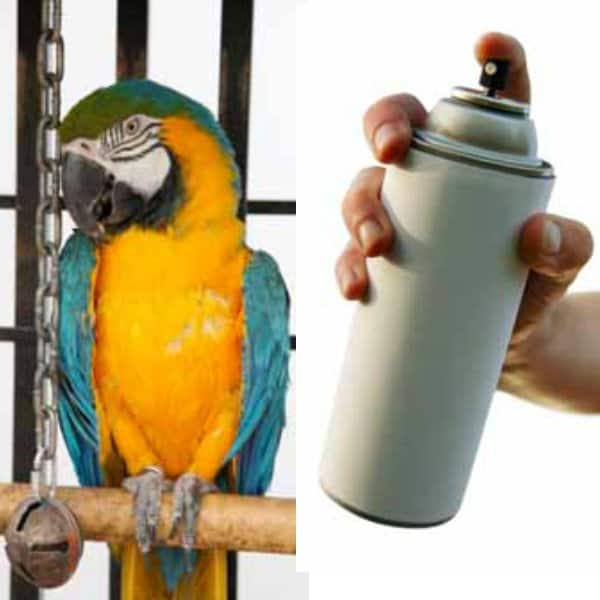Last Updated on by Catherine Tobsing
I think the main reason that people don’t try to paint older bird cages is because of what they’ve heard or read about the harmful effects of lead, zinc, and so forth.
The point that needs to be made is that most of the paints sold in the US for the past 40 years can be safe for human infants – as long as it’s dry.
Our government really wasn’t thinking about our birds – they were looking out for our children. The government has gone to great lengths to ensure that paint sold for use in the home is safe. The confusing issue is something called “Flashing”.
Flashing describes the chemicals that you should be concerned about, evaporating from the paint. These are solvents known as “VOC’s” (Volatile Organic Compounds).
VOC’s are why you need to keep the area you’re painting the cage in, well ventilated even when using what is known as safe paints. The danger is not in the paint itself but in those chemicals that leave the paint.
Think about it, look around and you’ll probably see paint on most of the walls in your home that have had no negative impact on your bird(s).
People restore older bird cages for a number of reasons.
They might not have the funds to replace a birdcage even though the birdcage they have now is beginning to deteriorate. They might have an older birdcage that is simply irreplaceable like the old California Cages or the all-welded Prevue cages. Big heavy wrought iron enclosures that are not available any longer.
Some people may acquire a bird that comes with a cage that’s too small or old, to begin with.
Because of its size, it may wear quicker than a bigger birdcage. In many instances such as these, we know people that have upgraded to a larger birdcage and then re-finished the older original smaller cage and then used it as a sleeping or travel cage.
Preparation ~ Remember, preparation is more important than painting
- Use a wire brush to remove any loose finishing
- Sand all the metal by hand
- Use your hand to closely check for metal “smoothness”
- Use a (paint) factory-recommended primer
- The paint you choose should not contain lead, zinc, or chromate
You can now buy VOC free paint found here (as an example)
Is “high adhesion”, formulated to bond with the metal surface
- Should be high quality, high gloss spray paint
- Is hard-wearing
- Is fast drying
Many brands will have a picture of a baby crib or a mother holding a child – look for indicators such as these.
- Before you paint remove the bird(s) to a different room or another location altogether.
- The room you paint in should be well-ventilated.
- Thin coats are best.
- Use a backdrop like a large sheet of cardboard behind the cage to catch excess paint.
Second Coats
- Second coats are not a bad idea
- Follow the manufacturer’s recommendations
- Apply second coats before the first coat is fully cured
When you’re done
- Wait at least a week – proper drying is critical to a hard finish
- Warming the cage with sunlight will help the paint shrink tight
- Don’t cover a freshly painted cage with the bird in it
If your bird seems to be wearing out the paint on the birdcage
Make sure there are lots of interesting perches to climb on.
Every parrot cage (for hookbill birds) should have at least 3 textures of bird perches – softwood, hardwood & rope (or fabric).
Birds love to climb, and paint damage often occurs from birds’ gripping the cage with their beak and nails to assist them in climbing up the cage.
Aviculturists have reported that, by wiring (we use cable ties) perches or appropriately-sized tree branches onto the inner sides of the bird cages, the birds will be encouraged to climb from place to place by gripping these with their beaks, so that they do not even touch the wire bars when climbing.
Bird Cage Painting FAQs
I’m concerned about your posted info on restoring cages… according to 2 well-respected avian vet specialists in my area, it is NOT safe to use any type of store-bought paint on a parrot cage-powder-coated is the only acceptable method.
These vets have no reason to push powder coat other than genuine care about bird safety.
My sources: Dr. Fern Van Sant, DVM-she has published articles on zinc toxicity and other topics-owns avian practice in San Jose, CA.
Dr. Michael Murphy, DVM-head vet at a specialist practice in Monterey, CA.
Just wanted to let you know. – Sue and birds Bodhi & Chipper
Hi Sue
Thank you for contacting us.
We appreciate the feedback.
That’s old-school thinking as you can now buy VOC free paint found here.
Most people do not understand powder coating.
Unless the metal (substrate) is prepared properly, the powder coat will not adhere well.
As a former partner in a small powder coating facility (Shelf-Kote, Barrington Illinois) and having sold thousands of cages, I can say with certainty that a bad powder coat job is far more hazardous to birds because of the potential for flaking off an ill-prepared substrate.
UNLESS YOU KNOW WHERE THAT CAGE CAME FROM YOU WON’T KNOW THE POWDER COATING IS BAD until your bird starts dropping chips on the bottom of their cage (or they get caught in their digestive system).
There are differences between Thermoplastic powders that will remelt when heated and Thermosetting powders that will not remelt upon reheating.
Some powder coat companies recycle the powder coat – great for outdoor furniture – and bad for birds.
Further, a powder coat job over metal with too much zinc or rust will not protect the bird.
There are factories in China with leaky roofs that produce thousands of cages that have been powder coated over rust and are sold here in the US.
So to say powder coat is the ONLY way to coat a birdcage is actually not correct.
If you look at the cheap bird cages on eBay, with no brand names they may look just like the ones we sell from AE, Prevue and Kings.
But would not trust them to place a rescued street pigeon in, in spite of the fact they have been powder coated.
Until next time.
Mitch Rezman
Windy City Parrot, Inc.
Author Profile
Latest entries
 The Traveling BirdJune 26, 2025Can You Name 5 Parrot Species That Are Living Wild in the USA?
The Traveling BirdJune 26, 2025Can You Name 5 Parrot Species That Are Living Wild in the USA? Bird BehaviorJune 26, 2025How is it Parrots Are Problem Solvers Social Animals and Even Use Tools?
Bird BehaviorJune 26, 2025How is it Parrots Are Problem Solvers Social Animals and Even Use Tools? Bird & Parrot AnatomyJune 25, 2025How a Tiny Chemical Modification Makes Parrots Nature’s Living Paintings
Bird & Parrot AnatomyJune 25, 2025How a Tiny Chemical Modification Makes Parrots Nature’s Living Paintings PigeonsJune 20, 2025How Do Parrots Thrive in Cities Outside Their Native Habitats?
PigeonsJune 20, 2025How Do Parrots Thrive in Cities Outside Their Native Habitats?






MnTennis11502
24 Oct 2020Hello. Thank you for the post, and including a link to a VOC safe paint. I figured there had to be some sort of safe paint out there, since the cages were painted in the first place, right?
I am curious what you think about using liquid sandpaper to prep the cage prior to painting. While I know the fumes from this are toxic (therefore, keep away from the bird!), it seems to me that prep and getting a good surface for adhesion are key to ensuring that the refurbished cage is safe. Liquid sandpaper seems to be a good way to do that.
Thanks in advance for any thoughts or info you can give.
Barbara Gonzalez
2 Feb 2021I actually bought an older wrought iron cage and refurbished it for my parrot. Definitely a process, but it was worth it. Funny that you referred us to ECO paints, they’re probably one of the only Zero VOC paints I came across. Although, note that no true paint is zero VOC, the ECO paint is at 1-2 g/l. Still great though. I used ECO for priming and then for finish color. I think I undid the value when I sprayed a clear coating on the cage to prevent rusting though. The cage was outside for a few months as I was only able to work on it some weekends, so it aired out quite nicely. Before I put it in the house I made sure to wash it well to rid of any paint/coating residues. Unfortunately I am not able to upload pictures of my hard work.